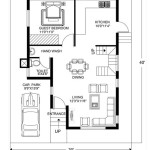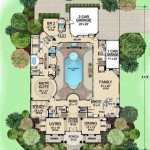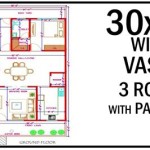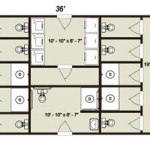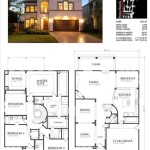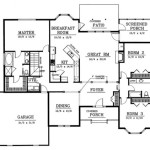Simple 5 Bedroom Floor Plan With Dimensions
Finding the perfect 5-bedroom floor plan requires careful consideration of various factors, including lifestyle, family size, and budget. A simple, well-designed layout can optimize space and create a comfortable living environment for everyone. This article explores key elements of a functional and efficient 5-bedroom floor plan, incorporating dimensions to provide a clearer understanding of the spatial arrangements.
Key Considerations for a 5-Bedroom Floor Plan
Several factors influence the design of a successful 5-bedroom floor plan. Addressing these early in the planning process ensures a home that meets specific needs and preferences.
* Lifestyle: Consider how occupants will utilize the space: formal or informal living? Frequent entertaining? Work-from-home needs? * Family Size and Dynamics: A large family might require distinct private and shared spaces. Multi-generational living may necessitate separate living areas. * Future Needs: Anticipate potential changes like expanding families or aging parents. Flexible spaces can adapt to evolving needs. * Budget: Establish a realistic budget to guide design choices and prevent overspending. * Lot Size and Orientation: The available lot size and its orientation impact the overall footprint and placement of rooms.
Optimizing Space in a 5-Bedroom Home
Efficient space utilization is crucial in any home, especially one with multiple bedrooms. Strategic planning can maximize functionality and comfort.
* Open Plan Living: Combining the living, dining, and kitchen areas creates a sense of spaciousness and fosters interaction. * Multi-functional Spaces: Consider rooms that serve dual purposes, such as a guest room that doubles as a home office. * Storage Solutions: Incorporate ample storage throughout the house, including closets, built-in shelving, and under-stair storage. * Traffic Flow: Design hallways and doorways to minimize congestion and ensure smooth movement between rooms.
Example 5-Bedroom Floor Plan with Dimensions (Option 1: Single Story)
This single-story layout prioritizes accessibility and open-plan living. It is suitable for families with young children or those who prefer single-level living.
* Dimensions: Approximately 2,800 sq ft (260 sq m) * Master Suite: 16 ft x 14 ft (4.8m x 4.2m), including a walk-in closet and en-suite bathroom. * Bedrooms 2-4: 12 ft x 10 ft (3.6m x 3m) each, with shared access to a bathroom. * Bedroom 5/Guest Room: 14 ft x 12 ft (4.2m x 3.6m), located near a separate bathroom. * Open Plan Living Area: 24 ft x 20 ft (7.3m x 6m), encompassing the living, dining, and kitchen areas. * Utility Room: Located near the kitchen for convenient access.
Example 5-Bedroom Floor Plan with Dimensions (Option 2: Two-Story)
A two-story design maximizes space on a smaller lot and offers greater privacy for bedrooms.
* Dimensions: Approximately 3,200 sq ft (297 sq m) * Ground Floor: Features an open-plan living area, one bedroom (or guest suite), a bathroom, and a utility room. * First Floor: Contains the master suite and three additional bedrooms, along with a shared bathroom and potentially a smaller living area or study. * Master Suite: 18 ft x 15 ft (5.5m x 4.5m), with a walk-in closet and en-suite bathroom. * Bedrooms 2-4: 12 ft x 11 ft (3.6m x 3.3m) each. * Open Plan Living Area (Ground Floor): 26 ft x 22 ft (7.9m x 6.7m).
Placement of Bedrooms within the Floor Plan
Careful consideration of bedroom placement can enhance privacy and minimize noise disruption.
* Master Suite: Often located away from other bedrooms for maximum privacy. * Children's Bedrooms: Can be grouped together, fostering a sense of community and simplifying supervision. * Guest Room: Ideally situated near a bathroom and away from the main living areas for guest convenience. * Noise Considerations: Place bedrooms away from noisy areas like laundry rooms or entertainment spaces.
Importance of Natural Light and Ventilation
Incorporating natural light and ventilation enhances the overall well-being of occupants.
* Window Placement: Strategically position windows to maximize natural light in all rooms. * Cross-Ventilation: Design windows and doors to facilitate cross-ventilation, promoting fresh air circulation. * Orientation: Consider the orientation of the house to optimize sunlight exposure throughout the day. * Skylights: Incorporate skylights in hallways or rooms with limited access to natural light.
Adaptability and Future-Proofing the Design
Planning for future needs can extend the lifespan and functionality of the home.
* Flexible Spaces: Design rooms that can adapt to changing needs, such as a bedroom that can be converted into a home office or playroom. * Accessibility Features: Consider incorporating features that cater to aging in place, like wider doorways and grab bars in bathrooms. * Technology Integration: Plan for smart home technology integration for enhanced convenience and energy efficiency.

The Marseille 5679 5 Bedrooms And 3 Baths House Designers Bedroom Plans European

5 Bedroom 4 Bath House Plans

Portable Simple 5 Bedroom Duplex Floor Plan Sample Peteroz Construction Blog

5 Bedroom House Plans Floor

Room To Grow 5 Bedroom House Plans Houseplans Blog Com

Mediterranean Style House Plan 5 Beds 3 Baths 4457 Sq Ft 320 1469 Plans One Story 6 Bedroom

5 Bedroom House Plan Examples

5 Bedroom House Plans Monster

The Best 5 Bedroom Barndominium Floor Plans

Image Result For Small 5 Bedroom House Plans Home Design Floor

